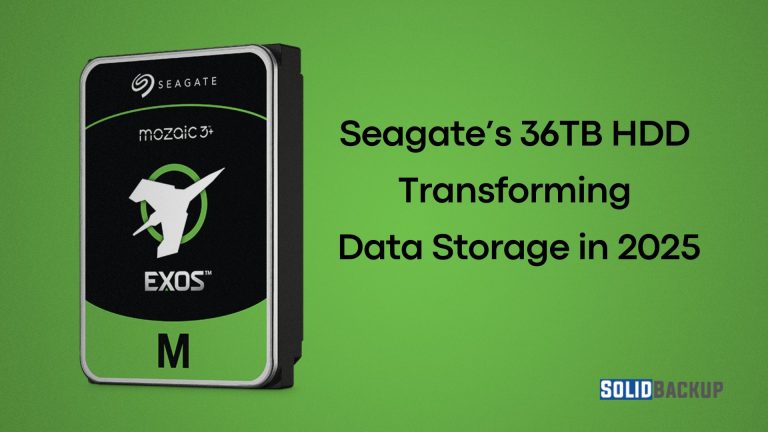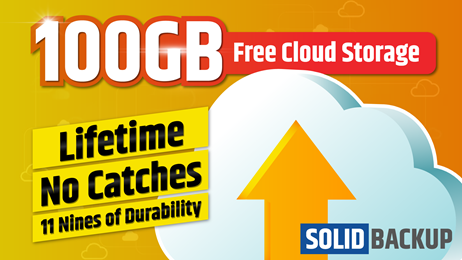
As data creation surges in 2025, from high-definition videos to AI-driven analytics, the need for massive storage solutions has never been greater. Seagate has risen to the challenge by launching the 36TB Exos M hard disk drive (HDD), the world’s largest HDD, and announcing a 60TB model in development. These breakthroughs transform how individuals, businesses, and data centres manage data, offering cost-effective, high-capacity storage.
What Are Seagate’s 36TB and 60TB HDDs?
Seagate’s 36TB Exos M HDD, released in January 2025, holds the world’s largest hard drive title, surpassing its 28TB Exos model from 2024. Part of the Exos family, it’s designed for enterprise use, targeting data centres and businesses with vast storage demands.
Using Heat-Assisted Magnetic Recording (HAMR) technology, the drive packs 3TB per platter in a standard 3.5-inch form factor. Seagate also revealed a 60TB HDD in the works, with platters already demonstrated, and is aiming for release in the coming years. Plans include 40 TB+ drives by 2026, 50TB by 2028, and 100TB by 2030, driven by needs in AI, high-performance computing (HPC), and cloud services.
These HDDs are significant because they provide enormous storage in a single device, reducing costs and complexity for large-scale data management. They’re ideal for enterprises but benefit individuals through more affordable cloud services powered by these drives.
How Do These HDDs Work?
The 36TB Exos M leverages HAMR technology, which uses a laser to heat disk platters, increasing data density. Seagate can fit 3TB on each of the drive’s 10 platters, achieving 36TB without enlarging the drive’s size. HAMR ensures reliability and efficiency, making it perfect for 24/7 data centre operations. The upcoming 60TB model will likely use enhanced platters to double capacity while remaining compatible with existing server systems.
These drives slot into data centre servers or storage arrays for users, storing everything from backups to AI datasets. While priced for enterprises (estimated at £20/TB, or ~£720 for 36TB), their impact reaches consumers through cost savings on cloud storage and backup services.
Why Seagate’s HDDs Are a Game-Changer in 2025
Seagate’s 36TB and future 60TB HDDs address the growing storage demands of 2025. Here’s how they make a difference:
1. Meets Exploding Data Needs
With 8K videos, AI models, and big data analytics creating massive datasets, storage requirements are soaring. The 36TB HDD offers a single-drive solution for:
- Enterprises: Store petabytes for machine learning, financial records, or media archives.
- Cloud Providers: Power platforms like Google Drive or Backblaze handle data more efficiently.
- Consumers: Enjoy cheaper cloud services as providers use high-capacity drives to cut costs.
The 60TB model will push this further, supporting next-generation applications like generative AI or immersive virtual reality.
2. Lowers Storage Costs
High-capacity HDDs reduce the cost per terabyte, making storage more affordable:
- Data Centres: One 36TB drive replaces multiple smaller drives, saving on power, cooling, and space.
- Cloud Services: Providers can offer larger storage plans at lower prices, benefiting users of services like IDrive.
- Businesses: Store large datasets without investing in additional servers, keeping budgets in check.
At ~£20/TB, a 36TB drive is more cost-effective than many 10TB drives (£25/TB). The 60TB model could lower this further, stretching storage budgets.
3. Boosts Backup Efficiency
Backups are critical for protecting data from hardware failures or cyberattacks. Seagate’s HDDs enhance backup processes by:
- Maximising Capacity: Store full system backups on one drive, including apps and settings.
- Improving Speed: High-density platters enable faster data transfers, speeding up backups.
- Supporting Cloud: Data centres using 36TB drives can manage more backup data, improving services like Acronis.
4. Scales for Enterprise Needs
Businesses need storage that grows with them. Seagate’s HDDs deliver:
- Reliability: HAMR ensures durability for constant use in data centres.
- Scalability: Add 36TB drives as data needs increase, with 60TB models offering future-proofing.
- AI and HPC Support: Handle massive datasets for AI training, scientific research, or video production.
These drives form the backbone of cloud and backup services, ensuring seamless scalability.
Practical Applications in 2025
Seagate’s HDDs have wide-ranging uses:
- Data Centres: Store vast amounts of cloud and backup data, reducing operational costs.
- Media Companies: Archive high-resolution films or game assets, like 8K video files.
- AI Firms: Manage terabytes of training data for machine learning models.
- Small Businesses: Use cloud services powered by these drives for affordable backups.
- Consumers: Benefit from lower cloud storage costs for photos, videos, or documents.
For example, a video editor storing 10TB of raw footage can rely on cloud services using 36TB drives, paying less than with smaller drives. The 60TB model will make this even more efficient.
Challenges to Consider
Despite their advantages, these HDDs have limitations:
- High Initial Cost: At £720 for 36TB, they’re pricey for individuals, though enterprises see long-term savings.
- Enterprise Focus: Built for data centres, not home use, limiting direct consumer access.
- Energy Use: Large data centres need more power and cooling, increasing data centre expenses.
- SSD Rivalry: Solid-state drives (SSDs) offer faster speeds but smaller capacities (max ~30TB in 2025), making HDDs better for bulk storage than performance tasks.
HDDs remain the top choice for high-capacity, cost-effective storage, especially for backups and archives.
Who Benefits from These HDDs?
- Data Centres: Manage more data with fewer drives, cutting costs and complexity.
- Businesses: Store large datasets for AI, finance, or media affordably.
- Cloud Providers: Offer cheaper, high-capacity storage and backup services.
- Individuals: Save money on cloud plans as providers leverage these drives.
Tips for Using High-Capacity HDDs
To make the most of Seagate’s HDDs in 2025:
- Compress Files: Shrink files before storing to maximise drive capacity and save costs. Learn more about how file compression can save money and reduce file size.
- Choose Cloud Services: Opt for providers like Backblaze that use high-capacity drives for affordable storage.
- Plan Scalability: Businesses should invest in storage arrays with 36TB drives to handle growth.
- Mix with SSDs: Use HDDs for bulk storage and SSDs for tasks needing speed, creating a hybrid setup.
Conclusion
Seagate’s 36TB Exos M HDD and upcoming 60TB model are reshaping storage in 2025, offering unmatched capacity for enterprises, cloud providers, and data centres. By lowering costs per terabyte, speeding up backups, and supporting AI and HPC, these drives meet the demands of a data-driven world.
Businesses save on infrastructure, while consumers enjoy cheaper cloud services. Seagate’s HDDs provide a reliable, scalable solution as storage needs grow. Start exploring these advancements today to keep your data manageable and cost-effective!



